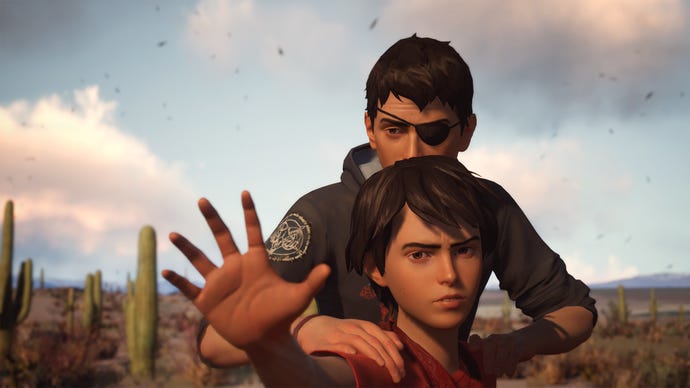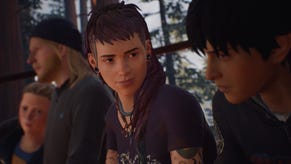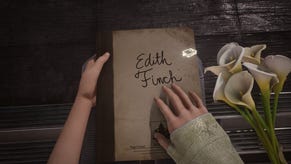The Life Is Strange 2 Postmortem: "[W]e Knew That It Wouldn't Have the Same Huge Success Right From the Beginning"
Life Is Strange 2's three creative leads tell us about the season's muted reception, intensive development, and more.
This article first appeared on USgamer, a partner publication of VG247. Some content, such as this article, has been migrated to VG247 for posterity after USgamer's closure - but it has not been edited or further vetted by the VG247 team.
Life Is Strange 2 wrapped up last week, with a finale that saw brothers Sean and Daniel's long west coast journey spiral to a close. It was a splintered finale too, with four major endings players could get—a stark contrast from the two blanket endings awaiting Max and Chloe at the end of Life Is Strange.
Spoiler Warning: This Q&A features spoilers for Life Is Strange 2 and Life Is Strange 1.
The endings split at two major directions; one in your control, one out of your control. In my ending, I had Sean drive forward through the police barricade rather than surrender himself—after all, his father was killed by a police officer for no reason, why would Sean feel safe surrendering himself to the same force? Only there was a twist: I raised Daniel to be a good kid; I was always nice to him, and taught him to not abuse his powers. As Sean drives forward and Daniel used his telekinetic powers to clear the path, he starts crying and says, "I didn't want to hurt anyone anymore." He then opens the car door and rolls out of the vehicle—leaving Sean on his own in Mexico, and Daniel (as we learn), on house arrest as he grows up.
It's a bittersweet ending. They send letters to each other, but they're apart now. Daniel lives with their grandparents from their mom's side, who they meet in Episode 2, while Sean lives happily in their father's hometown in Mexico with Cassidy, a side character Sean has a brief romance with in Episode 3 (if you so choose). It's, to me at least, a more satisfying ending than the wild unknown awaiting the end of Life Is Strange's final choice.
But my satisfaction with the ending was met with crickets online, thanks to the second season's largely muted reception overall. For all the fandom Life Is Strange brought into the world, was its sequel even making a sound? Life Is Strange 2, it seems, slipped the world by. Earlier this week, I sat down with co-creator and writer Jean-Luc Cano, co-director Raoul Barbet, and co-director Michel Koch to talk more about the development of the unlikely sequel.

USgamer: First, how does it feel having all five episodes out now? What has the episode-by-episode process been like this time around?
Raoul Barbet, co-director: We are really happy [all laughs] that it's finished because it was a long and difficult process. This game was really tough to create. And like, [episodic games] have some advantage, it was also really exhausting for the team and for us. I think we all are really happy that it's finished and we are even happier to see the feedback, because it's quite cool about Episode 5. I think players begin to really understand what we wanted to do with this game and the story we wanted to tell, so it's cool to see the big picture.
Jean-Luc Cano, co-creator, writer: I think we're also a little bit sad because Life Is Strange 2 was four years of our lives since the very beginning of the first idea of this story of Sean and Daniel. I think the first idea came in December 2015. So, yeah, it's been four years. [...] The journey is over for us, too. It's a little bit sad and nostalgic. The biggest feeling is we are happy. I think.
You mentioned that it was a difficult process. What were some of the biggest challenges you faced during development?
Michel Koch, co-director: The episodic structure is really complicated because each episode is like creating a whole small game. You have to begin it, finish it, push it to the stores and debug it, everything. So each episode is almost the same process as a big game, but then you have to directly go work and do the next episode, etcetera.
But other than that, this game was quite complicated for a lot of things. We would each say that the scale of the game was hard. Each episode has its own location, characters—so it meant most of the episodes have brand new assets. You have to create the new environment, the new characters, the new props. [If] it's a different season, we cannot always reuse the same trees or anything—we have to have snow for winter. And since it's new characters, we also have for each episode to do new castings; to find new voice actors for the new characters. Where in the first Life Is Strange, almost everybody was cast for Episode 1. I think there was only William [Chloe's dad] who came in Episode 3 when we had to cast a new actor, but other than that everybody was the same voice cast. So that's one example of something that's complicated in this game.
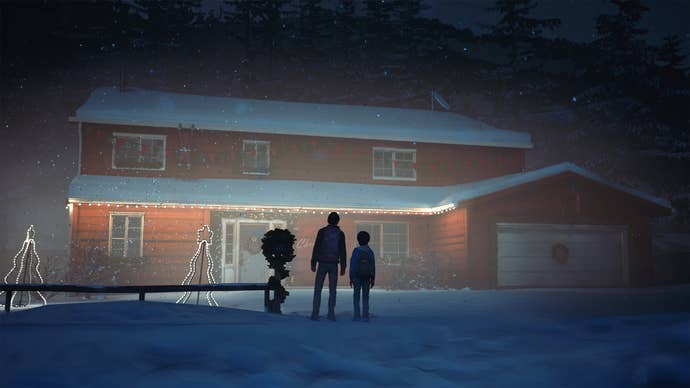
Speaking of that increased scale, in Episode 5 in particular, there are a lot more endings than there were in Life Is Strange 1. How did you approach widening that scope so broadly with the endings?
RB: Since the beginning, we wanted to have an interesting choice at the end. It's not only your choice, it's also the one of your younger brother and what you will do with your choice. It's like two multiplied by two. So we very quickly wanted those four endings, and after with some variation for sure, depending on the journey of the player. For us, it was an evolution of what we have already done. So it is a binary choice. But also this education aspect, which thanks to the character of Daniel. That's why the endings are truly focused on Daniel and what he is going to be. It was really here from the beginning of the writing process.
JLC: There is also the fact that in the first season of Life Is Strange, your last choice as Max didn't depend on what you had done before. It was the choice to finish the story you wanted to have. But in the second season, the last choice depended a lot on the decision you had made before, so the last decision you make as a player, Daniel will react differently because of everything you have done before. So that's something we wanted from the beginning, that Daniel took his independence at the end of the game.
MK: And we thought that since the endings are focused on Daniel, it was okay to tell more to the player of what's happening, because we are not taking away agency from the player and not exactly showing him what his character what Sean is doing at every step. We are showing to the player what Daniel will do, and that's something we thought was working. That's also why we didn't do it in the first game, because in the first game, you played the whole story as Max and we didn't really want to take away the agency from the player to decide after the ending. 'OK, so no, you don't play Max anymore, and we will decide for you what Max is doing.' In this case, in Life Is Strange 2, we are deciding what Daniel is doing, which I think it's OK to do because you never controlled Daniel.
Why the decision to bring back David, Chloe's stepdad, from the first Life Is Strange, who is basically given his own little epilogue in that trailer in Episode 5. Why was he the character you wanted to bring back into the story?
MK: Well, I think it was, I would say, two main reasons. The first reason—the simple one—is that he is one of the only characters that is alive in both endings, so we didn't have to create two bigger variations based on what the player did. He's just alive because you sacrificed Chloe or he was in the bunker arresting Jefferson if you decided to sacrifice Arcadia Bay. And it was also a character that we thought we could end his story arc.
Showing the end of his story arc in Life Is Strange 2 was a good way for us to talk about all the other characters; talk just a bit more about the casualties of the storm if you decided to save Chloe. Also, to just hint about what Max and Chloe are doing. We didn't want to tell too much about it, again, to not erase the possibility of the players to imagine what's happening to them. But we still wanted to show that to us, three years later, they're fine. They still exist, and just show to the player a glimpse of who they are becoming. And in the case of if you sacrificed Chloe, it was interesting to hear about some of Arcadia Bay, like what happened to Joyce. He was a character that allowed us to give a bit of information about those characters without going too much into it, or being too on the nose, or too much fanservice. I think it felt quite natural.
RB: It was a case in Season 1 that a lot of players hate him at the very beginning. And I think they learn to understand him a bit more, even if it is still not like him. So it was really cool to hear about his redemption and what he's doing all those years, so I think it's a very interesting character.
MK: Something that was important for us was also that if we brought back a character from Season 1, it needed to serve the story of Season 2. David was a good character to somehow be another voice. And Karen [Sean and Daniel's estranged mom], you have Karen who tells to Sean and Daniel that you need to live by your own rules and decide to do what you want. And David is more hinting at you that maybe you should comply with the rules of society and maybe you should turn yourself to the police. It was like having a counterpoint to some of the other characters in the way. So it was working. I mean, for someone who didn't play Life Is Strange 1, we still wanted the character that came back from Season 1 to work even if you don't know who he is.
Of the 4 main endings, is there one you consider to be canon?
JLC: I think it's for us, the same for the Season 1: you don't have any canon endings in Season 1. Both of the two endings are fine. It depends really to your playthrough, and that's okay. I think it's the same for the second season. There are many more endings, right now, but none of them is canon. It always depends on your playthrough and, if you're happy with your ending, that's what we want to achieve. So there are no canon endings in Season 2.
MK: And I think it was really important for us that those four endings all felt somehow balanced. That there is not really, I mean—there was shades of gray in all of those endings. There is no perfect ending. It is a thing that we also had in the first Life Is Strange: that you cannot have everything perfect even with a rewind. And here that's the same idea; we didn't want just one ending to feel like everything is perfect and they're just together, happy. Because no, I mean with what's happening, what happened during the game at a point, it will be complicated for those characters because they are facing the world around them that is in some way against them. So you have to balance and decide what is the compromise you're going to accept.
This game is also very influenced by modern American politics and society. For being a French studio, what were the challenges of trying to get that right?
MK: Yeah, that's a question we always asked ourselves: are we allowed to talk about this story? How can we make sure that we are not just giving the impression that we are the French guys who are using some kind of news just to use it to make some entertainment. So we documented ourselves a lot. We traveled; we did some road trip. Somehow the same kind of travel that the brothers are doing. We tried to talk to a lot of people we are meeting on the road. And some hitchhikers, some people who are just, the kind of people you meet in Episode 3; we talked to some of those working in pot farms. We tried to really talk to those people, so we knew that the way we would represent the situations would be inspired by real people and real events.
And then, of course, looking at documentaries and doing a lot of research to make sure that it's accurate. But I think that those themes and what we're talking about in this game, even as the game takes place in the United States; those are quite universal themes. I mean, in France and in Europe, we have a lot of issues with racism, with police violence. So this is even if we use the United States for Life Is Strange to represent those issues, those are wide world problems that we thought [are] important to talk about.
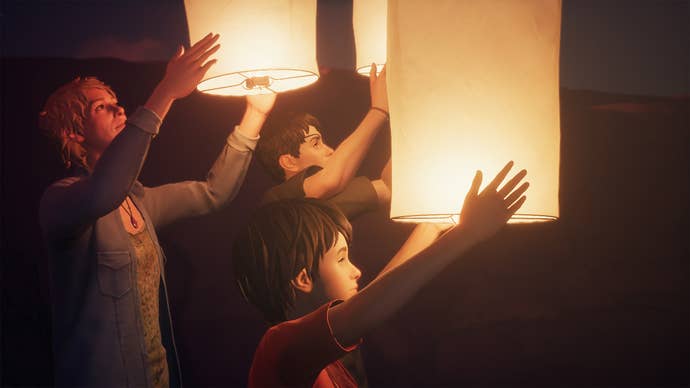
RB: And I think, yeah, video games is a great media to talk about those issues in particular. And it's interesting for us to put a player in a situation where he has to face those issues. So, of course, the story of Sean is quite often very dark sometimes, but it also I think it's realistic in our world. I know it is. So, yes, it's a story that could take place, of course, in Europe and in France for sure. But Life Is Strange was based here in USA, and we just, we tried to be realistic and to do a lot of research.
The fan response felt muted compared to Life Is Strange 1, which was on a lot more people's radars. The fan discussion was a lot quieter. What was that like, as developers making a sequel to this huge hit that managed to fly under the radar?
RB: Yeah, for sure.
MK: And I think for sure at the end of the first Life Is Strange, we knew that it was this huge pressure because of the big success of the first game that was quite unexpected for us; that it was so big. So I don't even know why it went that huge with the first game. Was it a good game at the right moment, at the right time? Or, I don't know.
So anyway, we knew that we wouldn't be able please every fan, because if we had another game with a Max and Chloe, we are sure that it wouldn't have been what the fans want. It would have disappointed them because they have so many stories about Max and Chloe in their heads. So many fanfiction, that whatever we did with Max and Chloe, a big part of those players would just dislike what we choose for Max and Chloe. That's why we decided to say not much about them in Episode 5. Just enough so it works, but not too much because it would also start to break what the player had in mind for them.
So we decided to go to another brand new story, new characters, new scene, and something that was well-set for us to tell. We are seeing, though, that with Episode 5, we have a lot of player that were reluctant to play the game, starts to play the five episodes back to back, and say that, 'Oh, I thought I wouldn't like those characters, but I like them.' I think it was a bit just, we knew that it wouldn't have the same huge success right from the beginning. I mean, it's a slow burn anyway, each time when you have a new story. The first Life Is Strange didn't have this huge fan base at Episode 1; it started to grow more and more after the episode, so we're hoping that now that it's released, it would really continue to grow, and maybe reach almost every fan of the first Life Is Strange? I dunno.
JLC: Fingers crossed.
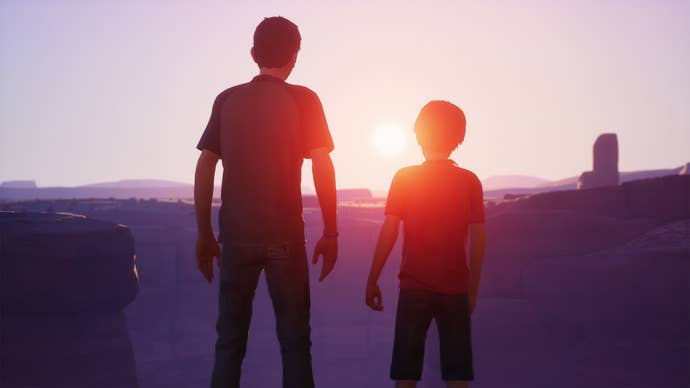
What's next for your team? Is there a Life Is Strange 3 in talks, something else entirely?
JLC: I think we don't really know yet because we are really focused on the last episode of Life Is Strange. I think for sure what we can tell is that we want to make another game, the three of us. So, it's been seven years now.
MK: It's not just the three of us. But yeah, as a beginning game.
JLC: It's been seven years we've worked together on the Life Is Strange universe. So yeah, we want to do something new, but we don't know what.
RB: We have to discuss a lot.
JLC: We have ideas of stuff, but not something that we can announce, as we are not fixed on something.
Is there anything else you want to say about Life Is Strange 2 now that it's wrapped up?
JLC: Play it.
RB: Just, at least you can play Captain Spirit. It's free. And if you like it, you can play Life Is Strange 2. No, we don't want to force people to buy something; so maybe you can test Captain Spirit. It's a good introduction.
JLC: And maybe to the fans of the first season who haven't played Life is Strange 2, give a chance to Sean and Daniel. Please.
MK: If they never gave a chance to Max and Chloe, they wouldn't know them. So if they don't give a chance to Sean and Daniel, they won't even know if they would like them or not.
